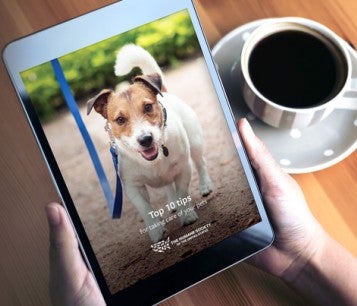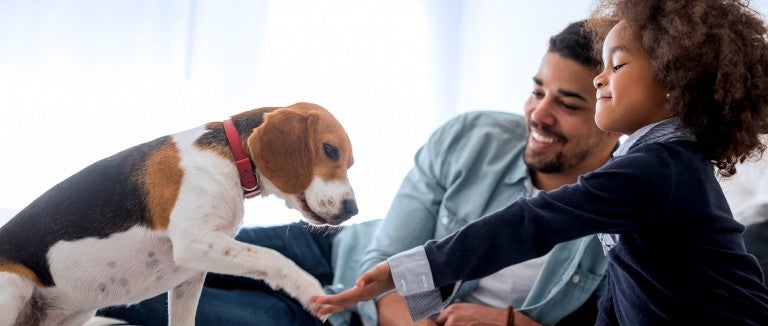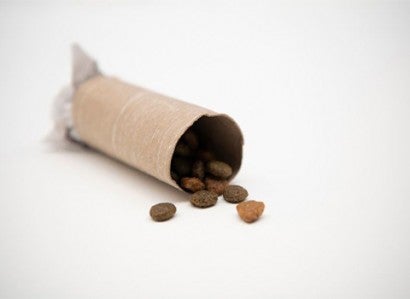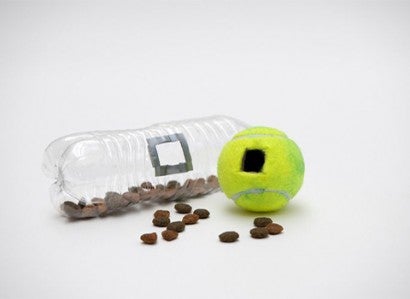Bringing a new dog into your life is an exciting event, but it’s also one that can be stressful for both you and your pup until you’ve settled into a routine. It can take days, months or longer for you and your pet to adjust to each other and for your dog to acclimate to your home, especially if your new pet has lived in multiple homes or shelters in the past.
Be patient, and use the following tips to help your pet adjust to the “new normal” and build a trusting bond with you.
Preparing your home
Gather supplies
Prepare the items your dog will need in advance. You’ll need a flat-buckle or martingale collar and identification tag, a harness and a 6-foot nylon leash, food and water bowls, a bed—and toys! We recommend toys that are unlikely to be swallowed, such as Nylabones (not to be confused with rawhide, which we don’t recommend), until you have a sense of whether your dog will shred or ingest toys.
You might also consider an appropriately sized crate or enclosed pet playpen that’s large enough for your dog to stand up and turn around in for use as a safe, quiet “den.”
If you know what kind of food your dog has been eating, buy a small bag to keep their diet consistent. You can always change food down the road, but you’ll want to gradually mix the current food with the new food to avoid upsetting their stomach.
Establish a routine
Determine your dog care regimen in advance with the human members of your household. Who will walk your dog and when? How often will you feed your dog? Will your dog be allowed on the furniture or will they initially need to adjust to a crate? Where will they rest at night? Are there any rooms in the house that are off-limits?
Plan the arrival
Arrange for your dog to arrive during a weekend or when you can be home for a few days. Get to know each other and spend some quality time together. For the first few weeks, you’ll want to make sure you establish a routine with your dog so they know what to expect and grow to trust you, but don’t rush your new dog into unfamiliar situations. It can be tempting to take them to a busy park or dog park or to bring them to the pet supply store to pick out toys, but most dogs will be overwhelmed simply by the transition to your home. So keep things as quiet and consistent as possible for the first week or more. Feed and walk your dog, and come and go from work around the same times each day.
When you do leave home, consider leaving your dog with an enrichment item, such as a stuffed treat toy or puzzle food bowl. This provides mental and physical distraction and can prevent issues such as separation anxiety.
- Introducing your new dog to your other dogs
- Does your dog freak out when you leave?
- Easy enrichment ideas for pets
Prepare for house-training
Assume your new dog is not house-trained and work from there. Be consistent and maintain a routine. Bear in mind that many house-trained dogs might initially eliminate in your home while they get used to a new environment and routine; you can prevent this by taking them out every few hours.
- How to house-train your dog or puppy
- Submissive urination: Why your dog does it and how to help them stop
Ensure all pets are healthy
If you already have dogs or cats at home, make sure they are up to date on their shots and in good general health before introducing your new dog. New family members can be stressful for pets, so you want all pets in your home to be mentally and physically healthy before adding any additional stress.
Take your new dog to the veterinarian within a week for a general health check, vaccinations and a preventative flea/tick medicine. It’s likely that your shelter, rescue or reputable breeder already vaccinated, microchipped and spayed or neutered your dog, but if not, you’ll need to request a microchip and make a spay/neuter appointment as well.
You'll need to make appointments for booster vaccinations throughout your dog's life. Most veterinarians will email you helpful reminders.
Sign up to receive our exclusive e-book full of important information about caring for your pet, including training techniques and answers to frequently asked questions.

The first weeks
Consider a crate
A crate may look to you like the canine equivalent of a jail cell, but to your dog, who instinctively likes to den, it can be a room of their own and can make crate training easier in some cases. The crate should be roomy enough to allow your dog to stand up, turn around and sit comfortably in normal posture.
Join a training class
Dogs want to make you happy! Use calm, firm, clear cues (a single, strong “no,” for example) immediately after they do something you’d like to correct or, better yet, reward them with praise, pets or treats immediately after they do something you like! It’s much easier to encourage your dog to do things you like than to stop them from doing things you don’t. Positive reinforcement training will also help you and your pet form a positive relationship. Consider signing up for an in-person or virtual dog obedience class or learning about positive dog training through online videos or books from your local library.
Long-term
Let the games begin
Dogs need plenty of playtime and exercise for their mental and physical health. That means you should plan games and exercise for your pet, from long runs, walks or hikes with larger dogs to a game of fetch with even the smallest dogs. Consider working with your dog to learn tricks—no dog is too old for new tricks!—and turning mealtimes into games by spreading wet food on a licking mat or spreading kibble on a snuffle mat (see below). Remember that a tired dog is a good dog: Dogs who are mentally and physically tired are much less likely to engage in boredom behaviors such as chewing or barking.
Create a movable feast
Make mealtimes a (supervised) puzzle for animals’ mental and physical enrichment.
Patience is key
Finally, remember to temper your expectations. Life with you is a different experience for your new companion, so give them time to adjust. You'll soon find out that you've made a friend for life. Don’t forget to reach out for help if you’re struggling with a behavior. The shelter or rescue where you adopted or the responsible breeder you purchased from can offer tips on basic behavioral challenges or refer you to a certified trainer if necessary.
No one will ever greet you with as much enthusiasm or provide you with as much unqualified love and loyalty as your dog will. Be patient, and you will be amply rewarded.



